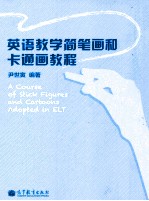图书介绍
英语教学简笔画和卡通画教程pdf电子书版本下载

- 尹世寅编著 著
- 出版社: 北京:高等教育出版社
- ISBN:7040391282
- 出版时间:2014
- 标注页数:384页
- 文件大小:59MB
- 文件页数:396页
- 主题词:
PDF下载
下载说明
英语教学简笔画和卡通画教程PDF格式电子书版下载
下载的文件为RAR压缩包。需要使用解压软件进行解压得到PDF格式图书。建议使用BT下载工具Free Download Manager进行下载,简称FDM(免费,没有广告,支持多平台)。本站资源全部打包为BT种子。所以需要使用专业的BT下载软件进行下载。如 BitComet qBittorrent uTorrent等BT下载工具。迅雷目前由于本站不是热门资源。不推荐使用!后期资源热门了。安装了迅雷也可以迅雷进行下载!
(文件页数 要大于 标注页数,上中下等多册电子书除外)
注意:本站所有压缩包均有解压码: 点击下载压缩包解压工具
图书目录
Part 1 Significance 1
Unit One Why do we adopt stick figures and cartoons in ELT? 2
1.1 What are stick figures and cartoons? 2
1.1.1 Definition of stick figures 2
1.1.2 Definition of cartoons 3
1.2 Significance of the adoption of stick figures and cartoons in ELT 4
1.2.1 Requirements of The National English Curriculum 4
1.2.2 Psychological functions 6
1.2.3 Satisfying students'needs 8
1.3 Principles and criteria of designing language teaching with pictures 10
1.4 Various sources and uses of stick figures and cartoons 11
Unit Two Characteristics of stick figures and cartoons 14
2.1 Simple 14
2.2 Clear-cut 19
2.3 Accurate 21
2.4 Flexible 27
2.4.1 Developing from basic figures to meaningful pictures 28
2.4 2 Omitting complex structures or relationships 29
2.4.3 Making the meaning reached by using exaggeration 30
2.4.4 Developing the plots by drawing a series of pictures 33
2.5 Direct 35
2.5.1 Breaking through the limit of space like young children's drawing 35
2.5.2 Reorganizing the sequences of time by shortening the time span 36
2.5.3 Directly presenting dialogues 37
2.5.4 Directly presenting physiological activities 41
2.5.5 Directly presenting psychological behaviors 42
2.5.6 Directly presenting causality 44
2.5.7 Directly presenting directions of actions 46
2.5.8 Directly presenting physical characters of the target objects 46
2.5.9 Directly presenting changes of nature 47
2.6 Pictographic 49
2.6.1 Pictographic nature reflected in ancient Chinese characters 49
2.6.2 Creating pictographic figures of English spelling 51
2.7 Descriptive and representative 54
2.7.1 Presenting abstract and complex theories and ideas 54
2.7.2 Presenting new topics 57
2.8 Meaningful 59
2.9 F unctional 62
Part 2 Skills 69
Unit Three Basic skills of drawing stick figures and cartoons 70
3.1 Prepa rations for your drawing 70
3.2 Basic lines and figures 71
3.3 Choosing proper lines and figures to draw stick pictures 72
3.4 Detailed descriptions in drawing cartoon pictures 74
Unit Four Diversity of drawing stick figuresarid cartoons 79
4.1 Humans 79
4.1.1 Alternatives of stick figures and cartoons 79
4.1.2 Proportion 84
4.1.3 Head and countenance 84
4.1.4 Body and limbs 86
4.1.5 Hands 89
4.2 Careers 93
4.3 Activities 102
4.3.1 School and social activities 102
4.3.2 Sports 107
4.4 Animals 116
4.5 Objects 140
4.5.1 Tools and living goods 140
4.5.2 Household appliances 146
4.5.3 Furniture 152
4.5.4 School things and stationeries 154
4.5.5 Musical instruments 161
4.5.6 Using personification 168
4.6 Plants 171
4.6.1 Trees 171
4.6.2 Flowers 173
4.6.3 Pot-flowers and bonsais 176
4.7 Vegetables and fruit 180
4.8 Food and drink 186
4.8.1 Chinese food and drink 186
4.8.2 Western food and drink 189
4.9 Clothing 194
4.10 Vehicles and transportation tools 199
4.11 Buildings and architectures 209
4.12 Locations and places 217
4.13 Countries,cities and places of historical interest 228
4.13.1 Capitals and countries 229
4.13.2 Famous cities and places of historical interest 232
4.14 Natural sceneries 239
4.15 Disasters and accidents 251
4.16 Customs 255
4.17 Religions 260
4.18 Festivals 264
Part 3 Application 271
Unit Five Stick figures and cartoons adopted in teaching language knowledge 272
5.1 Phonetics 272
5.2 Letters 275
5.3 Vocabulary 277
5.3.1 Nouns 278
5.3.2 Verbs 284
5.3.3 Prepositions 291
5.3.4 Adjectives and adverbs 294
5.4 Sentence patterns 299
5.5 Grammar 304
Unit Six Stick figures and cartoons adopted in teaching language skills 314
6.1 Listening with pictures 314
6.2 Speaking with pictures 324
6.3 Reading with pictures 329
6.4 Writing with pictures 335
Unit Seven Samples of designing classroom teaching with stick figures and cartoons 344
7.1 Word learning 344
7.2 Small book making 346
7.3 Introduction activities 349
7.3.1 Self introduction 349
7.3.2 Introducing a friend 353
7.3.3 Introducing a family 359
7.4 Looking for the differences 361
7.5 Spinners 363
7.6 Board games 364
7.7 Pair dictation and drawing/writing 367
Unit Eight Evaluation with pictures 369
References 379
Helpful web resources 383